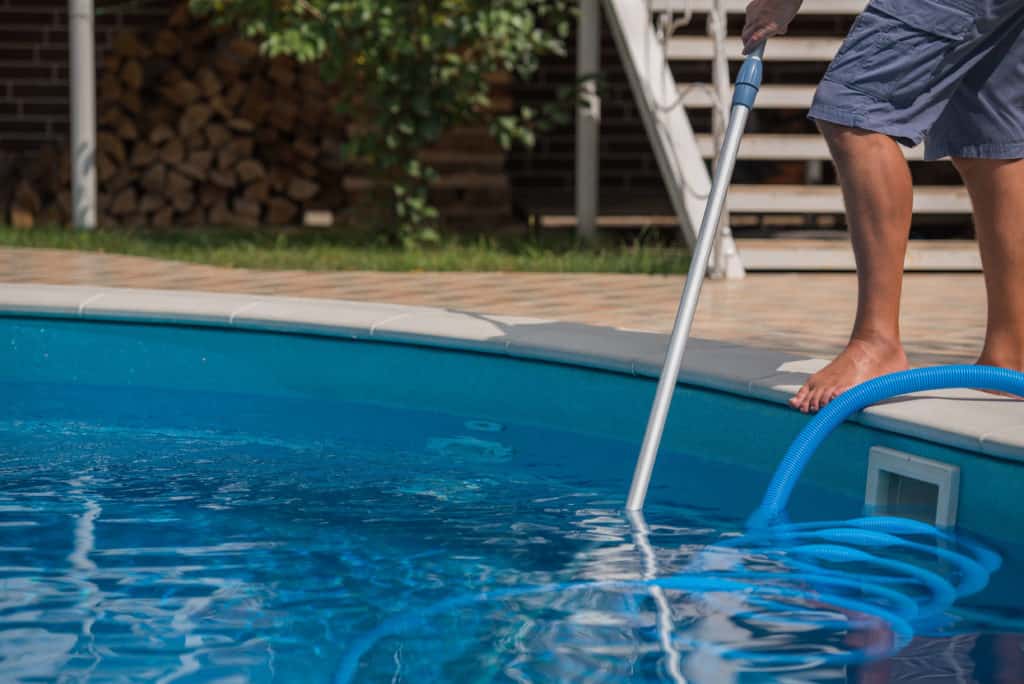Owning a swimming pool comes with regular maintenance procedures that include adding chemicals, vacuuming and cleaning. Moreover, cleaning your pool is one of the best ways to avoid a wide range of maintenance problems.
Vacuuming your pool is a necessary maintenance routine that keeps your pool clean and free from contaminants such as debris, mud, and algae that can compromise the pool water’s pH balance.
It’s advisable to vacuum your swimming pool at least once a week to keep the water clear and reduce chemical use and staining due to accumulation and decay of biological matter such as debris and leaves. However, it might be necessary to vacuum your pool more often especially when the pool is located near lakes or shade trees.
Vacuuming also makes it easier to control the water’s pH level. If the water isn’t clear, it’s an indication that your pool needs to be vacuumed. Besides being essential to clear pool water, a weekly vacuuming schedule also helps reduce the frequency of adding pool chemicals.
Indications to vacuum your pool

Sometimes it might be necessary to perform spot swimming pool vacuuming to clear it of debris that comes from summer storms. Although using a pool cover especially during extreme weather conditions is a practice, it might not be feasible under some situations.
Therefore, it’s important to check your pool on a daily basis when testing chemical levels to help determine whether it’s necessary to vacuum your pool more than once per week.
Seasonal swimming pool vacuuming
Preparing your swimming pool for winter storage and summer use is another time when thorough vacuuming is necessary. After draining your pool and prior to filling it, vacuum the pool to remove sediment and debris from the bottom.
By cleaning your pool thoroughly before winter storage, you can lessen or eliminate the volume of work required before opening your pool come summertime.
Vacuuming is also crucial at the beginning of the year or after windy storms. Things like small animals, dirt, leaves, mud and other pollutants can get into your pool during unpredictable weather events or over time.
Sometimes, pool covers are simply not enough to keep all these pollutants out. In such cases, a thorough vacuuming is necessary to clear all the debris.
After brushing your pool
It’s important to vacuum your pool after brushing debris from the ladder or steps of your pool in order to collect any debris that may settle at the bottom of your pool.
It is best to wait awhile after brushing your pool to allow the particles to float and settle on the bottom of the pool. Typically 45 minutes to 1 hour is sufficient, however the following day is a good rule to follow as long as swimmers won’t be jumping in the water for an early morning swim.
After a storm
Strong winds can dump leaves, debris, dust, and other pollutants into your pool. Therefore, it is essential to vacuum your pool after extreme weather conditions in order to maintain a clean pool where you can enjoy a refreshing swim at a moment’s notice.
Excessive usage
Fine debris such as dirt, sand and dust can be carried into your swimming pool on the feet of swimmers. Fine matter drifts to the bottom and forms a layer of sediment.
If you’ve been using your pool excessively, regular vacuuming is critical as it keeps your pool clean by removing the debris that accumulates on the floor or attaches to the walls.
To remove algae
If you swim in a pool with algae, you’ll often find that your skin becomes slimy as a result of algae attaching itself on your skin and swimming garments.
Although it’s not dangerous, algae can potentially frighten children and is aesthetically displeasing. Vacuuming your pool thoroughly on a regular basis can help get rid of pool algae and improve the aesthetic appeal of your pool.
If you have a significant algae outbreak, you may need to brush your floor and walls first to remove algae that has grown in the water prior to vacuuming.
Benefits of vacuuming your pool
- Prevent pool problems
Vacuuming your pool regularly helps prevent some of the problems that you can face. Problems such as bad odors, linear tears, or even algae blooms can be time consuming and expensive.
Algae blooms can make it unsafe to swim and mildew and bacteria can cause an unpleasant odor and keep you out of the pool. Vacuuming your pool regularly can help prevent these problems and give you peace of mind and a pleasant swimming experience for a long time.
- Chemical efficiency
Over the course of summer, your swimming pool’s chlorine levels and pH can be affected by the air, rain, and even the sun. Therefore, it’s particularly important for sanitizing chemicals to circulate throughout the pool in order to keep the water clean.
Vacuuming your pool on a regular basis helps improve the circulation of sanitizing chemicals by drawing water from the bottom of the pool to mix with the top. Better circulation leads to more efficient chemical use and consistent water balance.
- Keep water clear
Some problems in your pool are not related to bacteria, chemicals or algae. Sometimes, your swimming pools appearance is affected by backyard debris like leaves and twigs. Over time, debris from the air, debris from trees and debris brought in the pool by swimmers can build up in the water.
Vacuuming your pool helps improve its aesthetic appeal by keeping such materials out of the water and away from the filter and pump, leaving you with clear, beautiful water.
How to vacuum your pool manually
A manual pool vacuum cleaner typically comprises of a head, a telescopic pole and a hose.
Procedure
- Ensure the filter and pump are running.
- Attach the vacuum head to the telescopic pole. The pole is designed to help you move the vacuum inside your pool and collect all the debris and dirt.
- Connect the vacuum head to the hose and use a hose clamp to keep the hose in place.
- Immerse the head and the attached end of the hose in the water.
- Fill the hose with water by placing the unattached end near your swimming pool’s water intake or a return jet. The hose will sink and create suction once the hose line is filled with water and then attached to skimmer.
- Ensure the hose is filled with water to drive all the air out. Ensure that the inlet is the only line that is open to the vacuum pump. If not, the pump will also suck in debris and particles and undo all your hard work.
- Plug off all skimmers with water plugs but one, or close other valves to skimmers.
- Set the vacuum plate over the skimmer you wish to vacuum out of. If you don’t have a vacuum plate, take the waste bucket out and plug the vacuum hose into the hole at the bottom of the skimmer.
- Start vacuuming the pool at the shallow end, moving the vacuum head slowly in a back and forth manner along the floor, finishing in the deep end. If your pool has a lot of debris, you should stop vacuuming occasionally to clean out the pump basket and skimmer.
- Use the telescopic pole to move the vacuum head smoothly along the pool floor, sides, surface, and the steps of your pool, collecting debris along the way. Avoid clogging the vacuum by avoiding collecting large objects till the end of your pool vacuuming routine. You can also use a leaf skimmer or pool net to collect large debris and then start vacuuming your swimming pool. Take your time and do a thorough job, as pool vacuuming will also aid the filtering system.
- When you’ve finished vacuuming the pool, remove the vacuum hose from the skimmer.
- .Remove the winter plugs from the other skimmers.
- Remove the vacuum plate and turn the ball valves to open position.
- Turn off the pump and remove and empty the skimmer bucket.
- Empty pump strainer bucket if needed.
- Backwash the filter.
- Remove vacuum hose from the pool.
You should run your manual pool vacuum for as long as it takes to get rid of all the visible debris and dirt on the walls, floor and surface of the pool. It’s recommended that you start vacuuming at the shallow end of the pool and move slowly towards the deep end.
Work off a straight line and make sure you maintain an overlapping pattern to avoid missing any spots and leaving debris behind. You should also maintain a slow tempo to avoid kicking up debris, which can reduce visibility and take several hours to settle down.
If the water becomes cloudy, give it a few hours to settle before you start vacuuming again.
After vacuuming your pool
Once you’ve finished cleaning the pool, remove the telescoping pole from the vacuum head and drain water from the vacuum hose. Attach a cleaning brush to the telescoping pole, and scrub away any debris mud, dirt, or algae from the sides of your pool.
Add fresh water to your swimming pool to top off your water. Once you’ve restored the water level, test the water, and adjust the pH, chlorine and alkalinity as necessary.
Besides looking good, a clean pool is also free from harmful bacteria and dirt. If you’ve had unusual situations, such as lots of swimmers, a rain storm, or extreme winds, you should do extra pool vacuuming on as-need basis. You also need a regular maintenance schedule for shock treatments and tile and pump cleaning.
Although a swimming pool is a great investment, it’s also important to understand how to maintain it and keep it clean. Depending on where your pool is located and how often you use it, it is best to skim your pool daily and brush and vacuum it on a weekly basis.
